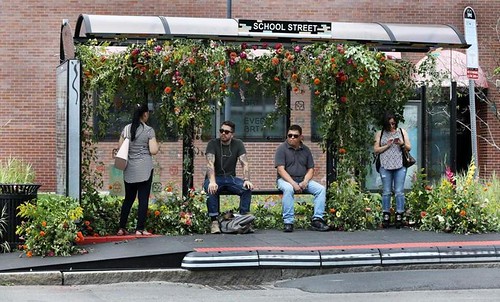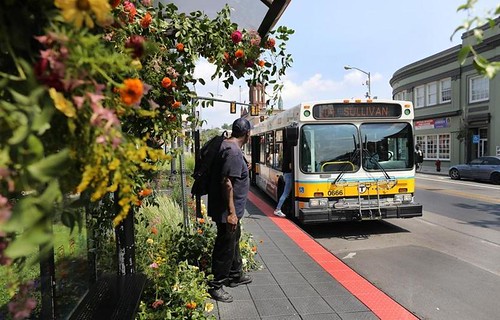Bus stop beautiful in Everett, Massachusetts
People involved in urban planning are familiar with the City Beautiful movement, an initiative mostly executed in the early part of the 20th Century, utilizing the Beaux Arts architectural form for majestic city buildings such as train stations, auditoriums, and city halls, along with statuary mostly of high ranking military officers on horses.
Washington's Union Station (above) and Post Office and the Civic Center in Cleveland are particularly noteworthy examples.
A few years ago in the Wall Street Journal I came across a mention of "railroad beautiful," which predates City Beautiful, and was pioneered by the Boston & Albany Railroad.
They hired architect Henry Hobson Richardson to design stations--he did nine--and Frederick Law Olmsted to design the grounds, out of the idea that attractive stations would attract riders to their passenger stations. After Richardson died, the railroad hired other architects to design similarly attractive stations elsewhere in the system.
So it's fitting that in Everett, Massachusetts, which while no longer being served by rail but once had a station stop on the Boston & Albany line, the local planning office worked with artist Krissy Price, to temporarily beautify with flowers a bus stop in the city which serves the MBTA bus system ("Everett tried to make a bus stop pretty" Boston Globe).
According to Everett transportation planner Jay Monty, “The idea was to make the bus stop a place you want to spend time, interact with your neighbors at, and bring more people to transportation,” he said. The city is considering other ways to spruce up the stop in the future, including opening an ice cream stand nearby.
Labels: bus transit, civic architecture, transit marketing, transportation infrastructure, urban design/placemaking







3 Comments:
yeah, your pic and the one after pretty dope. only would work in that specific city setting tho?
It would require daily maintenance. Which is beyond the capacity of most transit agencies. And is probably beyond the capacity of most transit shelter providers like Clear Channel.
But it would be cool to do this with a select number of stops.
They could be maintained by BIDs or other special purpose entities.
===
this is an element of what I call "design for maintenance." obviously a city agency wouldn't want to take this on.
there is a "legendary" story of a space in Tampa done by landscape architect Dan Kiley. It was super involved, super intensive to maintain. Once responsibility for the space shifted to the city, the quality of maintenance declined precipitously as did the space, because the requirements were far beyond what a typical city "parks department" does for a space [this is the whole reason that BIDs and parks conservancies like in NYC have been created, because the level of maintenance required and needed is beyond the capacity of the agency to provide].
This is an important lesson I think. For different reasons such a bus shelter are worth doing on a limited basis, but would as discussed above, require a different kind of special maintenance plan and arrangement.
these historical places and bus stops are awesome i like your post. thanks for sharing this important information.
Manchester airport cheap parking
Post a Comment
<< Home